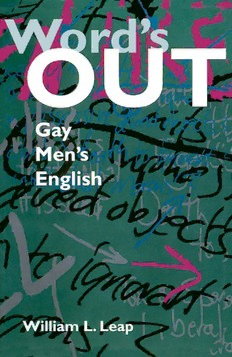Table Of ContentWord's
OUT
This page intentionally left blank
Words
OUT
Gay Men's English
William L. Leap
University of Minnesota Press
Minneapolis
London
Copyright 1996 by the Regents of the University of Minnesota
All rights reserved. No part of this publication may be reproduced, stored in a re-
trieval system, or transmitted, in any form or by any means, electronic, mechanical,
photocopying, recording, or otherwise, without the prior written permission of the
publisher.
Published by the University of Minnesota Press
111 Third Avenue South, Suite 290, Minneapolis, MN 55401-2520
Book design by Will H. Powers
Typesetting by Stanton Publication Services, Inc.
Graffiti by the University Avenue Gang, St. Paul
Printed in the United States of America on acid-free paper
Second printing 1997
LIBRARY OF CONGRESS CATALOGING-IN-PUBLICATION DATA
Leap, William.
Word's out: gay men's English / William L. Leap.
p. cm.
Includes bibliographical references (p. ) and index.
ISBN 0-8166-2252-3 (hardcover). - ISBN 0-8166-2253-1 (pbk.)
1. Gay men—United States — Language (New words, slang, etc.)
2. English language—Social aspects—United States. 3. English
language —United States —Slang. 4. Americanisms. I. Title.
PE3727.G39L43 1996
427'.973'086642-dc20 95-35967
The University of Minnesota is an
equal-opportunity educator and employer.
Contents
Examples
vii
Acknowledgments
ix
Introduction:
Studying Gay Men's English
xi
1
Can There Be Gay Discourse without Gay Language?
1
2
Gay English as Cooperative Discourse
12
3
Ensuring Cooperative Discourse:
Exaggeration, Turn Taking, Pauses, and Terminals
24
4
The Risk Outside:
Gay English, "Suspect Gays," and Heterosexuals
49
5
Claiming Gay Space:
Bathroom Graffiti, Songs about Cities, and "Queer" Reference
74
6
Language, Risk, and Space in a Health Club
Locker Room
109
7
Gay English in a "Desert of Nothing":
Language and Gay Socialization
125
8
Gay English and the Language of AIDS
140
Conclusion:
Gay English, Authenticity, and Performative Effect
159
Notes
165
Bibliography
173
Index
179
Examples
1.1 But you people are more fun 2
1.2 "Gay insulting" at the dinner table 6
1.3 What color is the brown water pitcher? 7
2.1 Sweatshirts 13
2.2 The Irish come to America 14
2.3 Sunday brunch 18
3.1 Vodka and tonic 25
3.2 Classic quotations from Tallulah Bankhead 27
3.3 Gay metaphor: Imagery and innuendo 28
3.4 Everybody loves Little Kiwi 31
3.5 How Philip met Eliot 40
3.6 Sleeping next to a hairy chest 46
3.7 A rough neighborhood at the gym 48
4.1 Opera on the farm 51
vii
4.2 Country music on the Hill 52
4.3 We don't believe in Santa Claus 53
4.4 Gay-centered messages and meanings in example 4.3 54
4.5 Just choose a number between one and four 64
5.1 Kill the queers 99
5.2 Sample texts: The queer logic of queer 105
5.3 Sample texts: Gay resistance to "queer" 106
7.1 "Identity confusion" in gay adolescents 127
7.2 Jokes as insights into gay culture 132
8.1 Representations of AIDS in three gay men's life stories 142
8.2 Differences between replies to Blond Hunk's 152
personal advertisements
8.3 Selected replies to Blond Hunk's advertisements 153
Acknowledgments
When I started writing this book, lesbian-gay language research was not a
visible theme in anthropology, sociolinguistics, or gender studies. I am
happy to report that these conditions have changed. I want to thank Ellen
Lewin, Esther Newton, Glorianne Leek, Birch Moonwomon, Kira Hall,
Anna Livia Braun, Martin Manalansan, Norris Lang, Ralph Bolton, Doug
Feldman, Michael Clatts, David Bergman, and Gil Herdt for the enthusi-
asm (and criticism) they have given to this project, especially when others
were less supportive of the endeavor.
Colleagues at The American University (Washington, D.C.) —particu-
larly Brett Williams, Elizabeth Sheehan, Lesley Gill, Geoff Burkhart, Ruth
Morgan, Mindy Michels, Alan Hersker, Christian Mendenhall, and Greg
Lewis —have supported my study of gay language-culture themes by lis-
tening to oral summaries of new ideas, reading draffs of papers and book
chapters, and providing new references and new research data. I am fortu-
nate to work in an academic environment that treats lesbian-gay studies so
positively.
Ellen Lewin, Ralph Bolton, and Gil Herdt made helpful comments on
the prospectus for this book. Gil gave the almost-final manuscript a very
close read and suggested a series of helpful adjustments, most of which I in-
corporated into the final text. Janaki Bakhle, my editor at the University of
Minnesota Press, nurtured this project unselfishly for several years, and I
have benefited immeasurably from her sound advice and guidance. Jeff
Moen and others at the University of Minnesota Press smoothed over many
a wrinkle during the production process, as did the copy editor, Kathy
Delfosse.
And thank you, Angui, for your usual "everything."
ix

